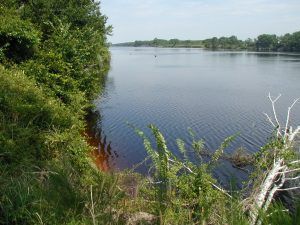April 15, 2024
What are PFAS?
 PFAS refers to a large and diverse class of human-made chemicals called per- and polyfluoroalkyl substances that have been manufactured and used worldwide, particularly in the United States, since the 1940s.
PFAS refers to a large and diverse class of human-made chemicals called per- and polyfluoroalkyl substances that have been manufactured and used worldwide, particularly in the United States, since the 1940s.
Why are PFAS Important?
These chemicals exist in many common consumer products that we use daily. They do not break down readily in the environment, meaning they can accumulate over time.
How are we exposed?

Most exposure to PFAS is from drinking water systems. However, they are found in many other places, including:
- Paper and cardboard food wrappers for fast food and bakery goods
- Non-stick cookware
- Commercial household, cosmetics, and personal care products
- Clothing labeled stain or water-repellent
- Stain-resistant furniture and carpets
- The workplace
- Living organisms
How Can PFAS Affect Our Health?

Chemical structure of Perfluorooctanesulfonic acid; a class of PFAS compound, and the key ingredient in a fabric protector.
Food and water that we consume may contain PFAS, which can accumulate in our bodies. According to the US EPA, there is evidence that exposure can result in adverse health effects, such as:
- Low birth weight
- Effects on the immune system
- Cancer
- Thyroid hormone disruption
For more information, please visit EPA’s page.
What’s happened?
- EPA PFAS Strategic Roadmap: In October 2021, the US Environmental Protection Agency (EPA) announced the agency’s Strategic Roadmap aimed at addressing PFAS contamination in drinking water and the environment. The plan includes steps to set regulatory limits, develop toxicity values for some PFAS compounds, and enhance monitoring and research efforts.
- The EPA issued a second Annual Progress Report in December 2023 that updated and reinforced the regulatory actions for PFAS.
- State-Level Regulations: Many US states have taken action to set their own regulations and standards for PFAS compounds in drinking water and the environment. These state-level regulations vary widely in terms of allowable concentrations and reporting requirements.
- Designation as Hazardous Substances: The EPA proposed designating PFAS compounds as hazardous substances under the Comprehensive Environmental Response, Compensation, and Liability Act (CERCLA) in April 2023.
- National Drinking Water Standards: With a number of states taking steps in recent years to regulate PFAS, significant federal actions are now looming. In March 2023, EPA proposed to establish legally enforceable levels for six known PFAS compounds.
- PFAS-Free Product Initiatives: Some countries and states have initiated programs to encourage or mandate the reduction or elimination of PFAS chemicals in consumer products like food packaging, cookware, and textiles. Check out a list of products without intentionally added PFAS or PFCs.
- International Regulatory Actions: PFAS contamination gained international attention in some countries, including European nations, taking steps to regulate and monitor these substances in various applications.
- Research and Monitoring: Ongoing research efforts have been focused on better understanding the health effects and environmental impact of PFAS compounds. Additionally, monitoring and testing programs are being expanded to identify and address PFAS contamination in drinking water sources and ecosystems.
Regulation
All PFAS are not the same. And the significant differences across compounds must be considered. Many state and federal regulators are closely examining these substances and are taking action through new laws and regulations.
EPA Announces Proposed Decision to Regulate PFAS in Drinking Water
July 2024 Update – On April 19, 2024, the EPA announced a newly finalized rule that represents a step towards the nationwide reduction of PFAS contamination. Two widely used PFAS chemicals, perfluorooctanoic acid (PFOA) and perfluorooctanesulfonic acid (PFOS), will be designated as hazardous substances under the Comprehensive Environmental Response, Compensation, and Liability Act (CERCLA), also known as Superfund, effective July 8, 2024.
April 2024 Update – The EPA finalized the First-Ever National Drinking Water Standard to Protect 100M People from PFAS Pollution.
March 2023 Update – The EPA proposed the nation’s first National Primary Drinking Water Regulation (NPDWR) for six PFAS chemicals. EPA anticipates finalizing the regulation by the end of 2023.
February 2020 Update – The EPA recently finalized a Significant New Use Rule that gives the agency the authority to review products containing PFAS prior to manufacturing, selling or importing into the US.
US EPA PFAS Action Plan
The US EPA has also outlined concrete steps and its proactive, cross-agency approach to address this and protect public health. Read more.
The industry is continuing to learn more about this class of chemicals and their effect on humans and the ecology. We pride ourselves in staying on the leading edge of environmental issues to meet our clients’ ever-changing needs.
While the EPA develops health-based regulations, several states continue to develop their own requirements. Manufacturers of PFAS compounds are developing safer substitutes, but compounds that are currently in the environment will persist. Government agencies and chemical manufacturers, assisted by environmental consultants, are defining the extent of the impact on the environment in drinking water sources such as rivers, lakes, wells, and public water treatment systems, and remediation technologies are being developed.
Contact Us
For more information on our Environmental services, please contact Environmental Service Line Leader, Vince Epps at vepps@smeinc.com.

